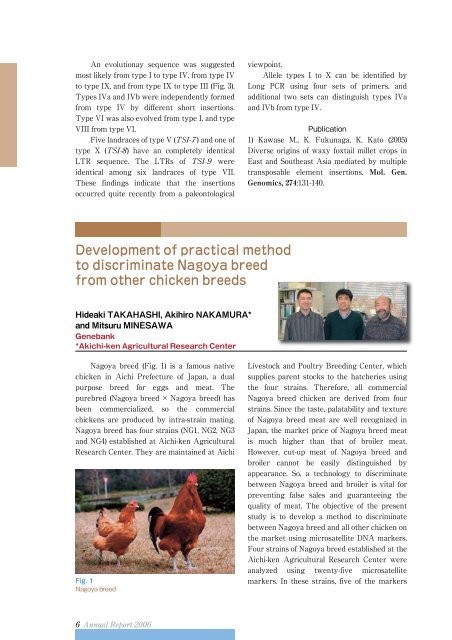Annual Report 2006
Annual Report 2006
Annual Report 2006
You also want an ePaper? Increase the reach of your titles
YUMPU automatically turns print PDFs into web optimized ePapers that Google loves.
An evolutionay sequence was suggested<br />
most likely from type I to type IV, from type IV<br />
to type IX, and from type IX to type III (Fig. 3).<br />
Types IVa and IVb were independently formed<br />
from type IV by different short insertions.<br />
Type VI was also evolved from type I, and type<br />
VIII from type VI.<br />
Five landraces of type V ( ) and one of<br />
type X () have an completely identical<br />
LTR sequence. The LTRs of were<br />
identical among six landraces of type VII.<br />
These findings indicate that the insertions<br />
occurred quite recently from a paleontological<br />
viewpoint.<br />
Allele types I to X can be identified by<br />
Long PCR using four sets of primers, and<br />
additional two sets can distinguish types IVa<br />
and IVb from type IV.<br />
Publication<br />
1) Kawase M., K. Fukunaga, K. Kato (2005)<br />
Diverse origins of waxy foxtail millet crops in<br />
East and Southeast Asia mediated by multiple<br />
transposable element insertions. Mol. Gen.<br />
Genomics, 274:131-140.<br />
Development of practical method<br />
to discriminate Nagoya breed<br />
from other chicken breeds<br />
Hideaki TAKAHASHI, Akihiro NAKAMURA*<br />
and Mitsuru MINESAWA<br />
Genebank<br />
*Akichi-ken Agricultural Research Center<br />
Nagoya breed (Fig. 1) is a famous native<br />
chicken in Aichi Prefecture of Japan, a dual<br />
purpose breed for eggs and meat. The<br />
purebred (Nagoya breed Nagoya breed) has<br />
been commercialized, so the commercial<br />
chickens are produced by intra-strain mating.<br />
Nagoya breed has four strains (NG1, NG2, NG3<br />
and NG4) established at Aichi-ken Agricultural<br />
Research Center. They are maintained at Aichi<br />
Fig. 1<br />
Nagoya breed<br />
Livestock and Poultry Breeding Center, which<br />
supplies parent stocks to the hatcheries using<br />
the four strains. Therefore, all commercial<br />
Nagoya breed chicken are derived from four<br />
strains. Since the taste, palatability and texture<br />
of Nagoya breed meat are well recognized in<br />
Japan, the market price of Nagoya breed meat<br />
is much higher than that of broiler meat.<br />
However, cut-up meat of Nagoya breed and<br />
broiler cannot be easily distinguished by<br />
appearance. So, a technology to discriminate<br />
between Nagoya breed and broiler is vital for<br />
preventing false sales and guaranteeing the<br />
quality of meat. The objective of the present<br />
study is to develop a method to discriminate<br />
between Nagoya breed and all other chicken on<br />
the market using microsatellite DNA markers.<br />
Four strains of Nagoya breed established at the<br />
Aichi-ken Agricultural Research Center were<br />
analyzed using twenty-five microsatellite<br />
markers. In these strains, five of the markers













